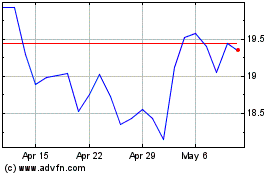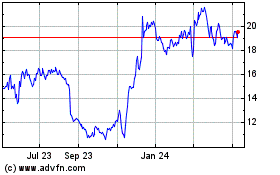Wal-Mart Lifts Profit Outlook as Sales Grow -- 3rd Update
August 18 2016 - 12:18PM
Dow Jones News
By Joshua Jamerson and Sarah Nassauer
Wal-Mart Stores Inc. is reaping the benefits of spending big to
boost sales, getting more shoppers through its doors at a time when
many retailers are struggling to attract foot traffic.
On Thursday the retailer said sales in existing U.S. stores rose
for the eighth consecutive quarter, up 1.6% as more customers
visited, providing a stark contrast to other retailers reporting
weak earnings in recent days including Target Corp. and Macy's
Inc.
The world's biggest retailer has poured billions recently into
making its U.S. stores more efficient and pleasant, boosting
employee wages and improve e-commerce operations as it tries to
fend off Amazon.com Inc.
"With transitions like this you tend to gain first with existing
customers," said Wal-Mart U.S. CEO Greg Foran on a conference call.
Those customers are visiting more often and "I think they are
putting an extra item in the basket because it's in stock or looks
fresh," said Mr. Foran.
Executives attributed sales gains in the U.S. to improvements
they have made to stores, as well lower gas prices which left
shoppers with more money to spend. Sales were hurt by deflationary
food prices, they said.
Wal-Mart lifted its per-share profit outlook for the year to
$4.15 to $4.35 and said third-quarter sales in existing U.S.
Wal-Mart stores would rise 1.0% to 1.5%. Shares, which were trading
near 52-week highs, rose 1.7% to $74.24 in midmorning trading.
Sales look strong, said John Zolidis, retail analyst at the
Buckingham Research Group in a note. "Unfortunately, the price of
this stability has been a multiyear erosion in margins and
profitability." Wal-Mart's profit [operating income] fell 7.2% in
the second quarter ended July 31.
Many traditional retailers have struggled recently to grow sales
and adjust to customer's changing online shopping habits. Target
said Wednesday that same-store sales fell for the first time in
more than two years and warned sales would fall in the next two
quarters. Macy's last week said it would shut 100 more stores, or
14% of its physical base, as shoppers increasingly opt to make
purchases online and spend more on services including travel and
health care than on goods.
In the second quarter, Wal-Mart reported global e-commerce sales
rose 11.8%, the first time in nine quarters the retailer's online
sales growth has increased quarter-over-quarter, but still slower
than the e-commerce market's growth overall.
Earlier this month, Wal-Mart agreed to purchase discount
e-commerce retailer Jet.com Inc. for $3.3 billion, the largest
acquisition of a U.S. e-commerce startup. Wal-Mart also said
current head of e-commerce Neil Ashe would be replaced by Jet's
founder Marc Lore to lead its e-commerce efforts once the deal is
complete. It expects to close the deal later this year.
Wal-Mart ramped up package delivery to lead its e-commerce
efforts speeds in the second quarter and started selling millions
more products on its website. In July Wal-Mart offered a free
monthlong trial of a $49 two-day shipping membership similar to
Amazon's popular Prime program, a sign that its delivery logistics
network is becoming more robust.
Walmart.com now sells 15 million items, said executives, as it
added more third-party sellers. Until May, the technology behind
Wal-Mart's website capped the number of products it could display
to shoppers at around 8 million, a major competitive weakness
compared with Amazon's hundreds of millions of available
products.
Wal-Mart is also trying to make its produce, meat and grocery
business more top-of-mind for shoppers, an effort at the heart of
its plan to fend off online retailers as consumers still tend to
shop offline for fresh food. During the quarter, the company
reported strong traffic in food and consumables, such as beauty and
cosmetics, in its grocery segment. The company also reported
stronger pharmacy sales, helped by drug price inflation and more
prescriptions filled.
Entertainment sales were soft. Target also reported weakness in
electronics sales. Consumers are still "a little more cautious than
the numbers might indicate," said Wal-Mart Finance Chief Brett
Biggs, on a conference call. "But overall we are seeing a consumer
that is acting quite steadily.
Overall, Wal-Mart reported earnings of $3.77 billion, or $1.21 a
share, compared with a year-earlier profit of $3.48 billion, or
$1.08 a share. Excluding the gain from the sale of its Yihaodian
website in China, the company earned $1.07 a share.
In U.S. stores, the bulk of Wal-Mart's revenue, 1.2% more people
shopped and spent 0.4% more. Sales in Wal-Mart's smaller format
Neighborhood markets rose 6.5% in the quarter.
Revenue edged up 0.5% to $120.85 billion. In constant currency,
revenue rose 2.8%.
Write to Joshua Jamerson at joshua.jamerson@wsj.com and Sarah
Nassauer at sarah.nassauer@wsj.com
(END) Dow Jones Newswires
August 18, 2016 12:03 ET (16:03 GMT)
Copyright (c) 2016 Dow Jones & Company, Inc.
Macys (NYSE:M)
Historical Stock Chart
From Mar 2024 to Apr 2024

Macys (NYSE:M)
Historical Stock Chart
From Apr 2023 to Apr 2024
